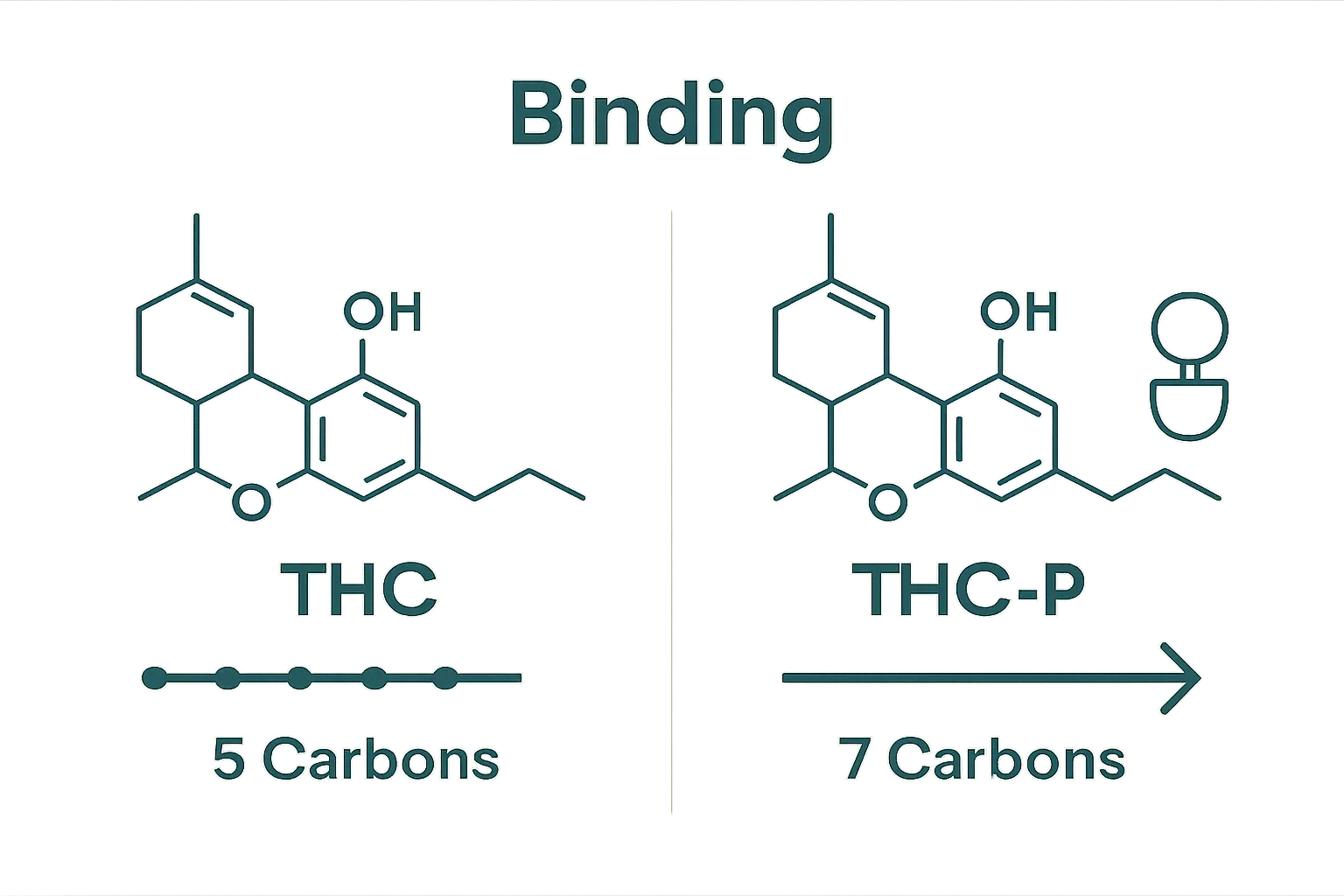THC-P shakes up what we thought we knew about cannabis. Scientists discovered this rare compound in 2019, and its potential is already grabbing headlines. Study findings show THC-P can have up to 33 times the binding strength of regular THC. That sounds wild, right? But here’s what really flips the script. THC-P is not just more powerful—it exists naturally in trace amounts in the same plants most people walk by without a second glance. This hidden powerhouse is set to change everything we know about cannabis effects and wellness.
Here is a breakdown of the primary characteristics and effects of THC-P described throughout this article to help readers quickly scan its main features.
| Feature | Description |
|---|---|
| Chemical Structure | Seven-carbon alkyl side chain, unique among cannabinoids |
| Receptor Binding Strength | Up to 33 times stronger than traditional THC |
| Natural Occurrence | Found in trace amounts in Cannabis sativa plants |
| Psychoactive Potency | More pronounced and intense effects compared to regular THC |
| Therapeutic Potential | May offer enhanced benefits for pain, anxiety, and inflammation management |
| Extraction Complexity | Requires advanced laboratory techniques due to scarcity |
| Recreational Implications | Potential for more controlled and refined psychoactive experiences |
Table of Contents
- Defining Thc-P: What Is It And Where Does It Come From?
- The Significance Of Thc-P: Why Does It Matter?
- How Thc-P Interacts With The Body: Understanding Its Effects
- Comparing Thc-P With Other Cannabinoids: Key Differences And Similarities
- Potential Applications And Future Of Thc-P In Wellness And Recreation
Quick Summary
| Takeaway | Explanation |
|---|---|
| THC-P is highly potent. | With receptor binding strength up to 33 times stronger than traditional THC, its effects are increasingly pronounced. |
| Naturally occurring compound. | THC-P is not synthetic; it is found in trace amounts in cannabis plants, requiring advanced extraction methods to isolate. |
| Enhanced therapeutic potential. | Its unique receptor engagement suggests improved effectiveness for managing pain, anxiety, and inflammation. |
| Significant recreational implications. | Users may experience more controlled and refined psychoactive effects compared to conventional THC consumption. |
| Represents cannabis science advancement. | Discovery of THC-P highlights the complex interactions of cannabinoids, paving the way for future research and therapeutic applications. |
Defining THC-P: What is it and Where Does it Come From?
THC-P represents a groundbreaking discovery in the cannabis research landscape, emerging as a potent and intriguing cannabinoid that challenges our understanding of hemp-derived compounds. First discovered by Italian researchers in 2019, this unique cannabinoid distinguishes itself through its extraordinary molecular structure and potential interactions with the human endocannabinoid system.
The Molecular Mechanics of THC-P
At its core, THC-P differs fundamentally from traditional THC through its unique carbon side chain. While standard THC contains a five-carbon alkyl side chain, THC-P boasts a seven-carbon side chain - a seemingly minor structural variation that produces significant biological implications. This extended carbon chain allows THC-P to bind more effectively with CB1 receptors in the human brain, potentially generating more pronounced psychoactive effects compared to traditional THC.
Key characteristics of THC-P include:
- Enhanced receptor binding: Up to 33 times more potent in connecting with cannabinoid receptors
- Rare natural occurrence: Exists in extremely minimal quantities within cannabis plants
- Structural uniqueness: Seven-carbon side chain distinguishing it from other cannabinoids
Origins and Natural Presence
Contrary to popular misconception, THC-P is not a synthetic compound manufactured in laboratories. It is a naturally occurring cannabinoid found within Cannabis sativa plants, though in extraordinarily trace amounts. Researchers utilize advanced extraction and isolation techniques to identify and concentrate this compound. Scientific studies suggest that its scarcity makes comprehensive research challenging, but the preliminary findings are remarkably promising.
For those interested in understanding more about cannabinoid interactions, our comprehensive guide on THC consumption provides additional insights into how these compounds interact with the human body. As research continues to evolve, THC-P represents an exciting frontier in cannabis science, offering potential therapeutic and recreational applications that extend beyond our current understanding.
The Significance of THC-P: Why Does It Matter?
The emergence of THC-P represents a pivotal moment in cannabis research, offering unprecedented insights into the complex world of cannabinoids and their potential interactions with human biology. Research indicates that this compound could revolutionize our understanding of cannabis therapeutics and recreational experiences.
Potency and Receptor Interaction
THC-P distinguishes itself through extraordinary receptor binding capabilities, demonstrating a level of potency that substantially surpasses traditional THC. Its unique molecular structure enables more robust interactions with the body’s cannabinoid receptors, potentially amplifying both therapeutic and psychoactive effects. This heightened receptor affinity suggests THC-P could deliver more pronounced experiences with smaller quantities compared to conventional cannabinoids.
Key potential implications include:
- Enhanced therapeutic potential: Possible increased effectiveness in managing pain, anxiety, and inflammation
- Reduced consumption requirements: Smaller doses might produce more significant effects
- Expanded research opportunities: New pathways for understanding cannabinoid interactions
Broader Cannabis Science Implications
Beyond its immediate effects, THC-P represents a significant breakthrough in cannabis research. Its discovery underscores the remarkable complexity of cannabis plants and challenges existing paradigms about cannabinoid functionality. Explore our comprehensive guide on minor cannabinoids to understand how compounds like THC-P are reshaping our comprehension of botanical wellness.
The scientific community views THC-P as more than just another cannabinoid. It symbolizes the ongoing evolution of cannabis research, highlighting how minute molecular variations can produce profound biological interactions. As researchers continue to unravel its mysteries, THC-P stands as a testament to the incredible potential hidden within cannabis plants, promising exciting developments in both medical and recreational domains.
How THC-P Interacts with the Body: Understanding Its Effects
The interaction of THC-P with the human body represents a complex biochemical dance that goes far beyond traditional cannabinoid experiences. Research reveals that this compound demonstrates remarkable engagement with our endocannabinoid system, potentially transforming our understanding of cannabinoid interactions.
Neurological and Receptor Engagement
THC-P distinguishes itself through exceptional receptor binding dynamics. Unlike standard THC, this cannabinoid exhibits an extraordinary affinity for CB1 receptors in the brain, suggesting potential for more intense and nuanced neurological responses. The seven-carbon side chain enables deeper penetration and more robust interactions with neural receptors, potentially producing effects that are substantially different from conventional cannabis compounds.
Key neurological interaction characteristics include:
- Enhanced receptor connection: Significantly stronger binding compared to traditional THC
- Potential amplified psychoactive experience: More pronounced neurological engagement
- Unique metabolic processing: Different interaction pathways within the endocannabinoid system
Physiological and Psychological Implications
The implications of THC-P extend beyond mere receptor interaction. Its distinctive molecular structure suggests potential for more targeted and potent experiences, which could have significant ramifications for both recreational and therapeutic applications. Our comprehensive guide on THC drink experiences provides additional context about how cannabinoids can influence bodily sensations.
Physiological responses may include altered pain perception, potential mood modulation, and unique metabolic interactions. The compound’s robust receptor engagement suggests it could offer more precise and controlled experiences compared to traditional cannabinoids, opening exciting pathways for future research and potential medical applications.
As scientific understanding evolves, THC-P represents a fascinating frontier in our comprehension of human neurological and physiological complexity.
Comparing THC-P with Other Cannabinoids: Key Differences and Similarities
The cannabis research landscape continuously evolves, with THC-P emerging as a fascinating compound that challenges our understanding of cannabinoid interactions. Scientific investigations reveal distinct characteristics that set THC-P apart from its cannabinoid counterparts.
Structural and Receptor Interaction Differences
THC-P distinguishes itself through its unique molecular architecture, particularly its seven-carbon side chain compared to traditional THC’s five-carbon structure. This seemingly minor variation produces profound differences in biological interactions. While standard THC demonstrates moderate receptor binding, THC-P exhibits substantially enhanced affinity for CB1 receptors, suggesting potentially more intense psychoactive experiences.

Key comparative characteristics include:
- Receptor binding strength: THC-P shows up to 33 times stronger connection with cannabinoid receptors
- Potency variation: More pronounced effects compared to traditional THC
- Molecular complexity: Unique side chain structure enabling different biological interactions
Comparative Psychoactive and Therapeutic Potential
Unlike non-psychoactive cannabinoids such as CBD, THC-P maintains a robust psychoactive profile. Our comprehensive guide on cannabinoid varieties explores the nuanced world of different cannabis compounds and their unique characteristics. THC-P represents a significant leap in understanding cannabinoid potential, demonstrating more targeted and potentially more controlled psychoactive experiences compared to traditional THC.
Where other cannabinoids might offer subtle effects, THC-P suggests a more pronounced interaction with the human endocannabinoid system. Its enhanced receptor binding could translate to more efficient therapeutic applications, potentially offering improved pain management, mood regulation, and neurological support.
To clarify the distinctions and similarities between THC-P and other major cannabinoids, the following table compares their key structural, psychoactive, and therapeutic features.
| Cannabinoid | Molecular Structure | Receptor Binding Strength | Psychoactivity | Potential Therapeutic Applications |
|---|---|---|---|---|
| THC-P | 7-carbon alkyl side chain | Up to 33x stronger than THC | Strongest among listed | Pain, anxiety, inflammation |
| Traditional THC | 5-carbon alkyl side chain | Standard | Strong | Pain, nausea, appetite stimulation |
| CBD | No significant alkyl side chain | Minimal for CB1/CB2 | Non-psychoactive | Anxiety, inflammation, seizure management |
| CBN | Mild modifications to THC structure | Weak | Mild, less than THC | Sleep aid, relaxation |
| CBG | Parent compound for other cannabinoids | Minimal | Non-psychoactive | Anti-inflammatory, neuroprotective |
| As research continues, THC-P stands as a testament to the incredible complexity and potential of cannabis-derived compounds. |
Potential Applications and Future of THC-P in Wellness and Recreation
THC-P emerges as a groundbreaking cannabinoid with promising potential across wellness and recreational landscapes. Research suggests that its unique molecular structure could unlock transformative applications previously unexplored in cannabis science.
Therapeutic and Wellness Potential
THC-P presents an exciting frontier in holistic wellness approaches, potentially offering more targeted and potent therapeutic interventions. Its extraordinary receptor binding capabilities suggest promising applications in managing complex physiological conditions. The compound’s enhanced interaction with the endocannabinoid system could revolutionize approaches to pain management, stress reduction, and neurological support.
Key potential wellness applications include:
- Targeted pain management: More precise neurological interaction
- Stress and anxiety modulation: Potentially more effective than traditional cannabinoids
- Neurological support: Enhanced receptor engagement for potential therapeutic interventions
Recreational and Lifestyle Implications
Beyond medical applications, THC-P represents a significant evolution in recreational cannabis experiences. Our comprehensive guide on cannabinoid varieties explores the nuanced world of cannabis compounds and their unique characteristics. The compound offers users a potentially more refined and controlled psychoactive experience, with the promise of more predictable and targeted effects compared to traditional THC consumption.
The future of THC-P extends beyond current understanding, potentially bridging wellness and recreational consumption. As research advances, this compound could reshape how we perceive cannabis interactions, offering more sophisticated and intentional experiences. Scientists and wellness professionals are increasingly interested in its potential to provide more precise, controlled, and potentially therapeutic cannabis interactions that align with modern wellness approaches.

Discover the Next Generation of Cannabis Wellness
Curious about how THC-P can transform your cannabis experience? You are not alone. Many readers like you want to understand what makes this new cannabinoid so unique and how its enhanced receptor binding and potency could open up new possibilities for both wellness and recreation. The article dives into the science behind THC-P, highlighting the need for products that match its advanced benefits without the confusion or guesswork. This is where we step in. Explore our THC collection to find products crafted for those who want more than the basics.

Take the step from curiosity to discovery with 23state.com. Experience carefully curated, hemp-derived products designed to maximize your wellness and recreational goals. Don’t wait for the cannabis industry to catch up—visit our site now and join a community looking for quality, transparency, and next-level cannabinoid experiences.
Frequently Asked Questions
What is THC-P?
THC-P (Tetrahydrocannabiphorol) is a newly discovered cannabinoid found in cannabis plants. It has a unique seven-carbon side chain that enhances its ability to bind to CB1 receptors in the brain, potentially leading to stronger psychoactive effects than traditional THC.
How does THC-P differ from traditional THC?
THC-P differs from traditional THC primarily through its molecular structure. While THC has a five-carbon side chain, THC-P has a seven-carbon side chain, allowing it to bind up to 33 times more effectively with cannabinoid receptors, which may result in more intense psychoactive experiences.
What are the potential benefits of THC-P?
THC-P may offer several benefits including enhanced therapeutic potential for managing pain, anxiety, and inflammation. Its efficient receptor binding suggests that smaller doses could produce significant effects compared to traditional cannabinoids, making it potentially beneficial for various wellness applications.
Are there any side effects associated with THC-P?
While THC-P has demonstrated promising effects, its psychoactive properties mean it may also produce side effects similar to traditional THC, including dizziness, increased heart rate, or anxiety in some users. As with any cannabinoid, individual experiences can vary, and further research is needed to fully understand its safety profile.

